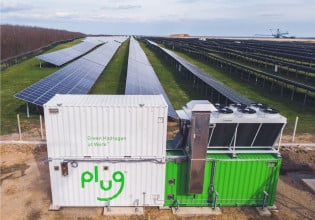Electrolytes Promise Progress in Lithium-Ion Batteries
Researchers are advancing the utility of silicon anodes for lithium-ion batteries. While silicon anodes have presented unique challenges, a new electrolyte formula might help overcome these limitations.
As engineers improve the performance of lithium-ion (Li-ion) batteries, they are studying and adjusting the components of the battery, including the cathode, anode, separator, and electrolyte solution. Each change is complex as it impacts the other components and can alter battery performance in unexpected ways. A research team led by Ann Mari Svensson, a professor at the Norwegian University of Science and Technology (NTNU), is developing a new electrolyte formula that pairs ionic liquids with a silicone anode to maximize battery charging performance.
Lithium-ion battery research. Image used courtesy of Argonne National Laboratory
Even while electric vehicle (EV) technology improves and the market grows, there are still significant obstacles to the widespread adoption of this sustainable mode of transportation. Battery charging speeds in particular have proven to be a hurdle for consumers who still prefer the familiar combustion engine.
According to the U.S. Department of Transportation, even Level 2 charging (the 208-240 volt options) can still take between 4 and 10 hours to charge an EV to 80%. By finding a way to improve silicon anode functionality, engineers may have discovered a way to maximize battery performance and improve the convenience of EV ownership.
Challenge of Replacing Graphite Anodes With Silicon
The predominant material used for the anode component of current Li-ion batteries is graphite because it offers a lightweight, durable, and safe functionality. But graphite is limited when it comes to energy storage. This drawback is particularly apparent when compared directly to silicon, which has a high theoretical gravimetric capacity at approximately 4200 mA h/g while graphite has only 372 mA h/g.
Even though silicon offers an obvious advantage with respect to energy storage capacity, the research community has struggled to overcome other problems that have hampered its implementation.
Video used courtesy of Norwegian Sci-Tech News
With every discharging and charging cycle, the silicon electrons swell dramatically, increasing almost 400% in volume. This repeated expanding and contracting places significant stress on the material, and as a result, the electrode particles exhibit cracking that creates actual gaps in space between the particles. These gaps significantly reduce conductivity, thus undermining the primary goal of battery functionality.
Heat can improve conductivity, but such heating for Li-ions increases the chance of dangerous thermal activity that can lead to fires. It turns out that changing the electrolyte formula might be the ideal complement to the silicon anode's high capacity for storage.
Using Ionic Liquids With Silicon Anode
Because of the expanding and contracting action of silicon electrodes while the battery cycles, the electrolyte interface layer becomes increasingly unstable. By swapping current electrolytes for ionic liquids, this instability can be reduced, thus overcoming a major hurdle to using silicon anodes in Li-ion batteries.
The low melting point of ionic liquids puts them in a totally liquid state even at room temperature. They not only reduce the possibility of fire, but they also facilitate the formation of a film over the silicon anode, which prevents the decomposition of the electrolyte. The pairing of this electrolyte with the silicon anode has pushed the research community one step closer to making the exceptionally high power storage capacity of silicon usable.
Improved Lithium-ion Performance and Large-Scale Applications
In addition to hastening EV adoption, this powerful combination can create potential impacts in multiple sectors. Drone technology has struggled because of how batteries limit range and flight times, but this boost in stored energy could enable long-range flight capabilities.
Li-ions are also the preferred storage technology for large-scale plants and play a critical role in grid resilience, so the incorporation of silicon’s higher storage capacity will make Li-ion batteries even more helpful for managing the grid.
Li-ion demand projections for EVs and storage. Image used courtesy of Statista
Engineers keep searching for new ways to improve Li-ion performance, and this new research into the battery materials themselves might have produced an effective combination of the silicon anode and the ionic electrolyte. As Li-ions grow in power storage capacity, become more stable, and develop high conductivity, they expand the horizons of the power sector in new directions.








